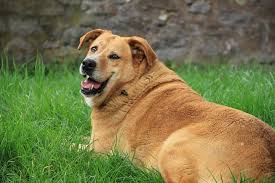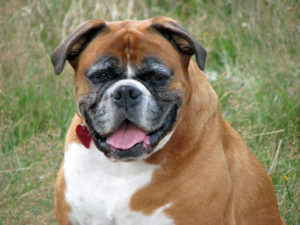There are two very basic reasons why your dog may be obese – high-calorie foods and not enough physical activities. However, it isn’t as obvious or as simple as it may sound. There are other factors such as hormone imbalances, reproduction status, genetics, neutering, alternating diet, free-feeding, certain medications, frequent treats, boredom, old age, and lack of adequate exercise. Although any dog breed or mix can be overweight certain breeds are more prone to it such as Dachshunds or Labradors.

Before making any lifestyle and diet changes for your dog, the first thing you need to do is consult with a veterinarian. As this is an important step into reaching your dog’s ideal weight, do not overlook it. The vet will examine your dog thoroughly by touching his/her ribs, lumbar area, tail, and head. Depending on what the particular dog breed standards are, the vet will discuss the results with you. If your dog’s current body weight is 10 to 15% higher than the ideal weight for the breed, your dog will be characterized as obese.
Focus on Nutrition
Keep a log of the number of meals and treats provided to your dog through the day. This includes any scraps you give them when you âre having your meals as well. Giving home-cooked meals and snacks is the perfect way to manage your dog’s weight. However, if this isn’t possible for you on a daily basis, purchase premium brand foods that provide adequate nutrition without aiding the weight gain.
Follow an Eating Schedule
 Ask the veterinarian to prepare a diet plan for your dog. This way, you won’t have to figure out what foods to give them for meals and snacks. The diet would mainly contain high-protein and high-fiber foods that are low in fat. Your dog will feel fuller for a longer time and won’t ask for extra treats. Just as humans, following this diet plan will increase your dog’s metabolism and energy levels. Shedding a few pounds doesn’t have to be a difficult task.
Ask the veterinarian to prepare a diet plan for your dog. This way, you won’t have to figure out what foods to give them for meals and snacks. The diet would mainly contain high-protein and high-fiber foods that are low in fat. Your dog will feel fuller for a longer time and won’t ask for extra treats. Just as humans, following this diet plan will increase your dog’s metabolism and energy levels. Shedding a few pounds doesn’t have to be a difficult task.
Resist the Temptation of Giving Into their Begging
This is a tough situation, but you have to be very strong. There may be times when your dog will whine or look at you with those sad eyes, and ask for treats. Do not give in and stay firm in your decision. If you are giving them the right portion size during meals and snack time, there is no reason to offer extra food even one time. You need to stay strong and make the decision of following the weight loss program. Your will power will determine the outcome of your dog’s overall progress.
Exercise is a Must
It goes without saying that along with a healthy and nutritious diet, your dog requires regular excise as well. Depending on your dog’s current weight and the ideal weight-loss goal, prepare a thorough chart of all the exercises and physical activities that need to be carried out on a daily basis. For a guide to how much exercise your particular dog needs see here.
Apart from walking and playing fetch, you can take your dog out for a swim as well. Swimming is one of the best exercises for dogs as it burns energy fast and being non-impact will help prevent injury. It is also great during a hot, summer day.
Take your dog to a doggy daycare where they can engage in a variety of physical activities with other dogs. That will motivate them to run and play around for a longer time. Alternatively, engage the services of a dog walker. For the best way to find a trusted pet sitter or dog walker for your home alone dog I highly recommend Rover.
Rover.com is a free pet sitting website or app for iPhone or Android devices that makes it easy for you to find the perfect pet sitter or dog walker in your location. They provide reviews of the pet sitters and dog walkers and also their availability in addition to how many repeat clients. In addition, you have the peace of mind of being covered by the Rover Guarantee. To learn more about Rover.com see here.
Click this link to receive $10 off your first booking with a Rover sitter or walker.
Making a Lifestyle Choice
 Whether you follow a diet and exercise routine set by the veterinarian, or you have come up with a plan yourself, it is necessary to schedule follow-up treatments and consultations with the veterinarian.
Whether you follow a diet and exercise routine set by the veterinarian, or you have come up with a plan yourself, it is necessary to schedule follow-up treatments and consultations with the veterinarian.
They will check your dog and determine whether the weight loss program is taking effect or not. Plus, you don’t want to go overboard and have your dog lose too much weight or cause an injury fro over exercise.
This will affect their health in an adverse way. You don’t want your dog’s weight to keep alternating as it is not healthy for them. Maintaining an ideal weight depending on your dog’s age is the perfect way to ensure their good health.
Perform these Simple Checks
As your dog’s weight-loss program advances, keep a close watch on your dog’s progress. Apart from the obvious decrease in weight, you can also see and feel the outline of your dog’s ribs. When excess fat that is covering their body is shed, the ribs and waistline are quite easily visible. Apart from this, your dog’s belly should also be tucked upward when you are looking at them from the side.
This video will show you how to do this.
Maintain Long-term Results
The goal is to bring your dog’s excess weight down and making sure that they don’t relapse in the future. This means that you cannot stop following a healthy lifestyle for your dog.
Your dog depends on you to make the right decisions that will affect their health and life. So, once the goal weight is achieved, you will have to continue your tireless efforts to maintain your dog’s weight.
This means, you too will have to make some changes in your lifestyle as well. Ditch the old habits of giving mid-meal snacks and treats, and instead, train your dog to accept healthy snacks and foods to eat throughout the day.
There are some serious medical conditions associated with dog obesity such as diabetes, pancreatitis, osteoarthritis, skin conditions, heart problems, urinary bladder stones, cancers, respiratory distress, and high blood pressure.
Apart from this, it is believed that heavier dogs have a shorter lifespan than leaner dogs. Which is why it becomes imperative that you seek proper medical advice from the veterinarian and follow a customized weight-loss and exercise program prescribed for your dog. On the other hand, if the reason behind your dog’s obesity is medical, the vet will ask you to give them medication.
Make a plan for your dog’s weight loss which will include the exact calorie intake for your dog on a day-to-day basis along with adequate physical activities to be carried out. Ideally, you should target a 1 to 2% loss of body weight per week. Once you have the instructions as to what steps need to be taken to improve your dog’s health, the implementation process will become quite simple.
